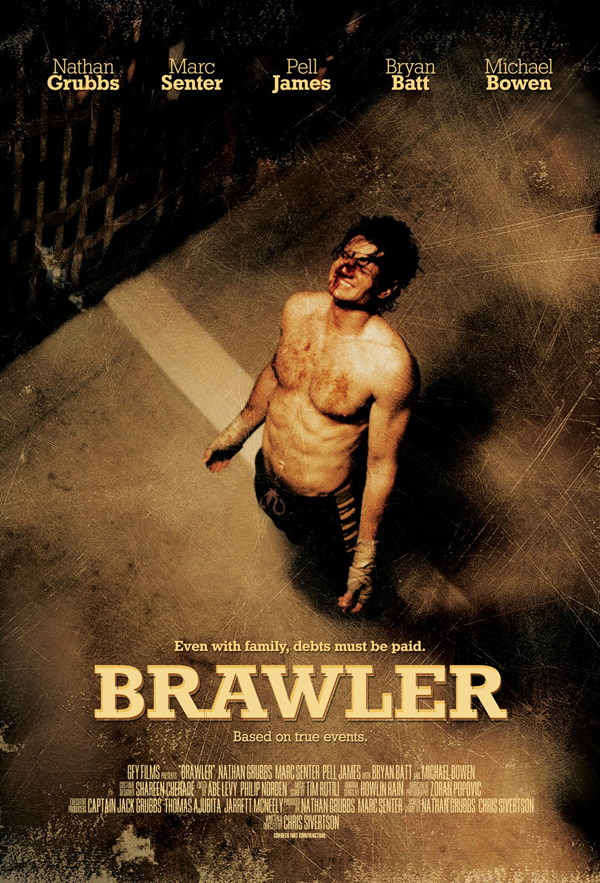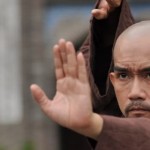Q&A: Chris Sivertson, Marc Senter and Nathan Grubbs on “BRAWLER”
 Director Chris Sivertson and actors/co-producers Nathan Grubbs and Mark Senter talk about their colourful, brutal depiction of underground UFC-style fighting
Director Chris Sivertson and actors/co-producers Nathan Grubbs and Mark Senter talk about their colourful, brutal depiction of underground UFC-style fighting
Interview by Kier-La Janisse
——————-
The Lost director Chris Sivertson reteams with Mark Senter (who brought The Lost’s character of Ray Pye to life with unforgettable delirium) for this colourful trip into the Louisiana underworld, based on a story by actor/co-producer Nathan Grubbs. Senter and Grubbs play Charlie and Bobby Fontaine, two brothers who make a living as illegal fighters in UFC-style games that take place in the hold of a ship anchored canada cialis no prescription just offshore from New Orleans. With a precarious, competitive relationship exacerbated by the gangsters, gamblers and beautiful female fight-junkies (including Pell James of Fanboys) that surround them, Charlie and Bobby’s world is about to take an apocalyptic turn that will test their loyalty to one another.
————
Can you tell me how the story came about, and what the adaptation process was like in terms of how you all collaborated?
SIVERTSON: Nate had heard an old story from his father about these two brothers in New Orleans who used to brawl for money on the Mississippi. He and Marc brought the female viagra next day delivery story to me and right away I thought it sounded like great material for a movie. We just talked about it a lot and I started writing. It all got going very quickly.
Marc – what prompted you to take this on as your first producing credit?
SENTER: I had known Nathan for a few years and was always intrigued hearing about the projects generic cialis cheap he had put together himself. Nathan is ambitious, passionate, artistic, a do-er not a try-er, and almost as impatient as me, so I knew we would make a great producing team. When he told me about this idea for a story of two brothers, I sat with it for a while and then brought it to Chris. I think I’ve always naturally been headed for the acting/producing direction and it just needed to be the right fit and Brawler was it.
Why did you choose to set the tale in New cialis online us Orleans, was this just based on the reality of an underground fight scene there or was it an aesthetic decision?
SIVERTSON: Both reasons really. New Orleans is such a vibrant, colorful place. There is no other order cialis online without prescription place like it in America. Or even the rest of the world. A good part of the movie was shot out on the streets with real people walking in and out of the shots, so the city became a character in its own right. The architecture is amazing, filled with just these beautiful old buildings. And even just the sounds of the city are fantastic, with wonderful music happening on almost every corner. There is such an energy there, so it was just an inspiring place to make a movie.
What kind of fight training did Marc and Nathan have to go through to prepare for the film?
SENTER: Growing up Nathan spent summers boxing in New Orleans. In preparation for the film he brushed up and improved his skills with Pepe Rilley at Freddie Roach’s (trains Manny Pacquiao) gym Wild Card in Los Angeles. He continued his training with Lenny Adams in New Orleans. I was big into martial arts growing up and earned my black belt in Karate at age 15. My character uses a combination of Jiu Jitsu and kick boxing, so in preparation, I first began with getting in the best physical shape possible so that I would have the strength and flexibility to execute certain moves. I began taking jiu jitsu and Kick boxing classes regularly. Kick Boxing came pretty naturally because of my Karate background, but the jiu jitsu was tough (I got my butt kicked!) and took a lot of work to feel comfortable and confident with some of the techniques. Matthias Meister at Nola BJJ was my number 1 guy who was responsible for preparing me. He is an excellent teacher and I couldn’t recommend him more.
Did you guys go to illegal fights at all before filming? How often do the fights happen, and how much crossover is there between people who bet on the fights and participate in other kinds of illegal gambling? (cockfights etc?)
GRUBBS: We most certainly did go to some underground fights prior to filming, and all I can say is that there is a whole other world of MMA going on right under our noses that few people know about. I would imagine that, yes, there is a cross over. These people are all business and no joke. That’s all I can say!
I’ve always found it strange that Louisiana (from my experience) is so ‘officially’ right-wing and yet at the same time very insistent on the government staying out of people’s business, almost like frontier life – how do you think this affects the world your story is set in?
GRUBBS: It’s perfect! Like you say, the city likes less government and less rules which is what these guys (Charlie and Bobby Fontaine) like until one to many rules are broken. BRAWLER goes hand and hand with New Orleans and the dislike for rules and reform which is subtly seen throughout the film.
Marc – you again play a loose cannon, where does the attraction come from for these kids of roles? (I know you’ve described you character in Red White and Blue as a nice, simple guy, but as an audience member I thought this character was equally complex and emotionally unpredictable)
SENTER: Yes, my character in Red, White, & Blue was a nice guy – a “mommas” boy who was dealt a really heavy hand and had an unfortunate extreme. I have always been intrigued by colorful characters, types who carry a lot of emotional fabric and are a bit more eccentric.
Why does Bobby resent Charlie so much, and conversely, why does Charlie have neverending compassion for his brother Bobby?
SIVERTSON: Bobby was so young when his father died, that Charlie is the only true father figure in his life. And it’s just natural to rebel against your father. The parent/child relationship is so charged and complicated, because there is such an intense love, but also a strong desire on the child’s part to establish his own identity. So that’s at play there. But it’s even more complicated than that because Charlie is not Bobby’s father, he’s his brother. So Bobby wants to be considered Charlie’s peer. But Charlie is older than him and has already established himself in the fight world, and in city life in general, and Charlie has an enormous amount of local respect – both for his fighting skills and for being a stand-up guy. So there is a part of Bobby that is jealous of that. Bobby doesn’t want to live in the shadow of his brother. Yet he still loves him fiercely. And as for Charlie… He has taken that father-figure role on without hesitation. And it’s natural for a parent to love their child no matter what. That doesn’t mean your kid doesn’t annoy the hell out of you sometimes, but no matter what that foundation of love is never shaken.
There’s a lot of alumni from The Lost on this picture, both in front of and behind the camera. What prompted this crew to come together again?
SIVERTSON: Making THE LOST was a very intense and special experience for a lot of us. Not only were we making a movie, but we were forming strong relationships that have only grown stronger since then. So it just felt natural for a lot of us to work together again.
SENTER: As us Italians say: “Keep it in the family!”
———————
BRAWLER has its World Premiere on Aug 3 at 7:30pm and screens again Aug 4 at 2:50pm, in the Salle JA DeSeve, hosted by Director Chris Sivertson and Actors/Co-producers Marc Senter and Nathan Grubbs. More info on the film page HERE.

 August 3, 2011
August 3, 2011 





Comments